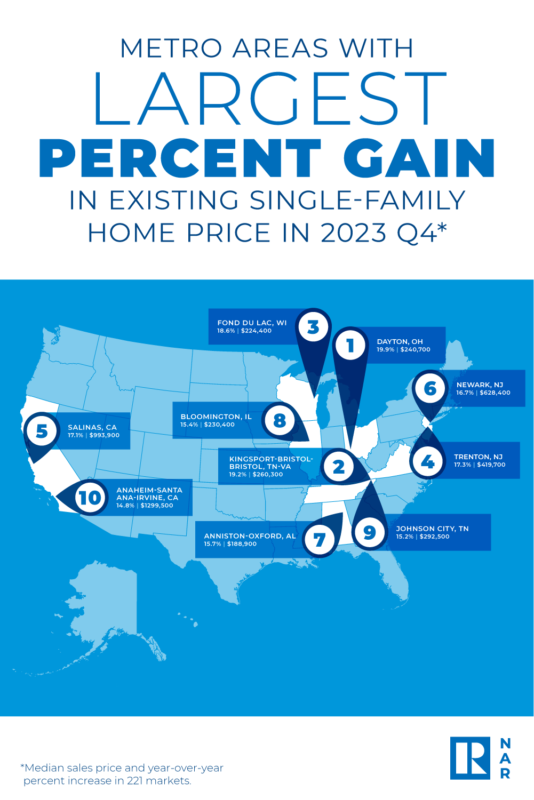Homeowners are growing their equity while buyers are getting sticker shock. Read more from NAR’s latest quarterly report.
Good news for homeowners, bad news for buyers: Home prices continued to surge in the fourth quarter of 2023 in the majority of major U.S. metros, and some markets even posted double-digit gains.
The national median price for an existing single-family home jumped 3.5% from a year prior, reaching $391,700, according to National Association of REALTORS® data. Last month, NAR reported that December home prices reached an all-time high. About 85 million homeowners saw gains in housing wealth in December as their equity continued to climb. But although homeowners are sitting on a healthy nest egg, “many home buyers have been shocked at high housing costs, with a typical monthly mortgage payment rising from $1,000 three years ago to more than $2,000 last year,” says NAR Chief Economist Lawrence Yun. “This doubling in housing costs … contributes to the sense of dissatisfaction about the economy.”
Would-be home buyers have varying budget considerations, depending on the area of the country they live in. Prices for existing single-family homes rose in more than 85% of the 221 markets NAR tracked in the fourth quarter of 2023. Fifteen percent—or 34 of the tracked markets—even posted double-digit price gains, up from 11% in the third quarter. The top 10 metro areas with the largest year-over-year median price increases in the fourth quarter of 2023 all recorded gains of at least 14.8%, NAR reports.
California remains the state with the highest home prices in the nation. Eight of the 10 priciest markets in the fourth quarter of 2023 were located in the Golden State. NAR’s report shows the following were the most expensive housing markets in the fourth quarter:
- San Jose-Sunnyvale-Santa Clara, Calif.: $1,750,300; 11%
- Anaheim-Santa Ana-Irvine, Calif.: $1,299,500; 14.8%
- San Francisco-Oakland-Hayward, Calif.: $1,251,000; 4.3%
- Urban Honolulu: $1,069,400; -1.9%
- Salinas, Calif.: $993,900; 17.1%
- San Diego-Carlsbad, Calif.: $931,600; 8.7%
- Oxnard-Thousand Oaks-Ventura, Calif.: $916,800; 7.9%
- San Luis Obispo-Paso Robles, Calif.: $912,100; 5.7%
- Los Angeles-Long Beach-Glendale, Calif.: $884,400; 6.7%
- Boulder, Colo.: $849,400; 11.8%
Affordability Pressures Continue, But May Be Improving
The average monthly mortgage payment on a typical existing single-family home, assuming a 20% down payment, was $2,163 in the fourth quarter, NAR’s data shows. That marks a 10% increase compared to a year ago. Mortgage rates have risen over the past year, reaching a peak of nearly 8% in the fall. Rates have since receded, settling in the mid-6% range over recent weeks.
As mortgage rates decline, housing affordability is improving, NAR’s report shows. Still, in the fourth quarter, a family needed a qualifying income of at least $100,000 to afford a 10% down payment mortgage in about 47% of the metro markets NAR tracked.
Nationwide, sales have been fairly restrained over the last few months due to limited housing inventory, Yun says. The shortage has been keeping upward pressure on home prices in many markets. Prices are expected to remain elevated, even as sales may soon pick up heading into spring: “Increased homebuilding, along with lower mortgage rates, will not only improve housing affordability but also help bring more homes onto the market in 2024,” Yun says.
Source: nar.realtor













